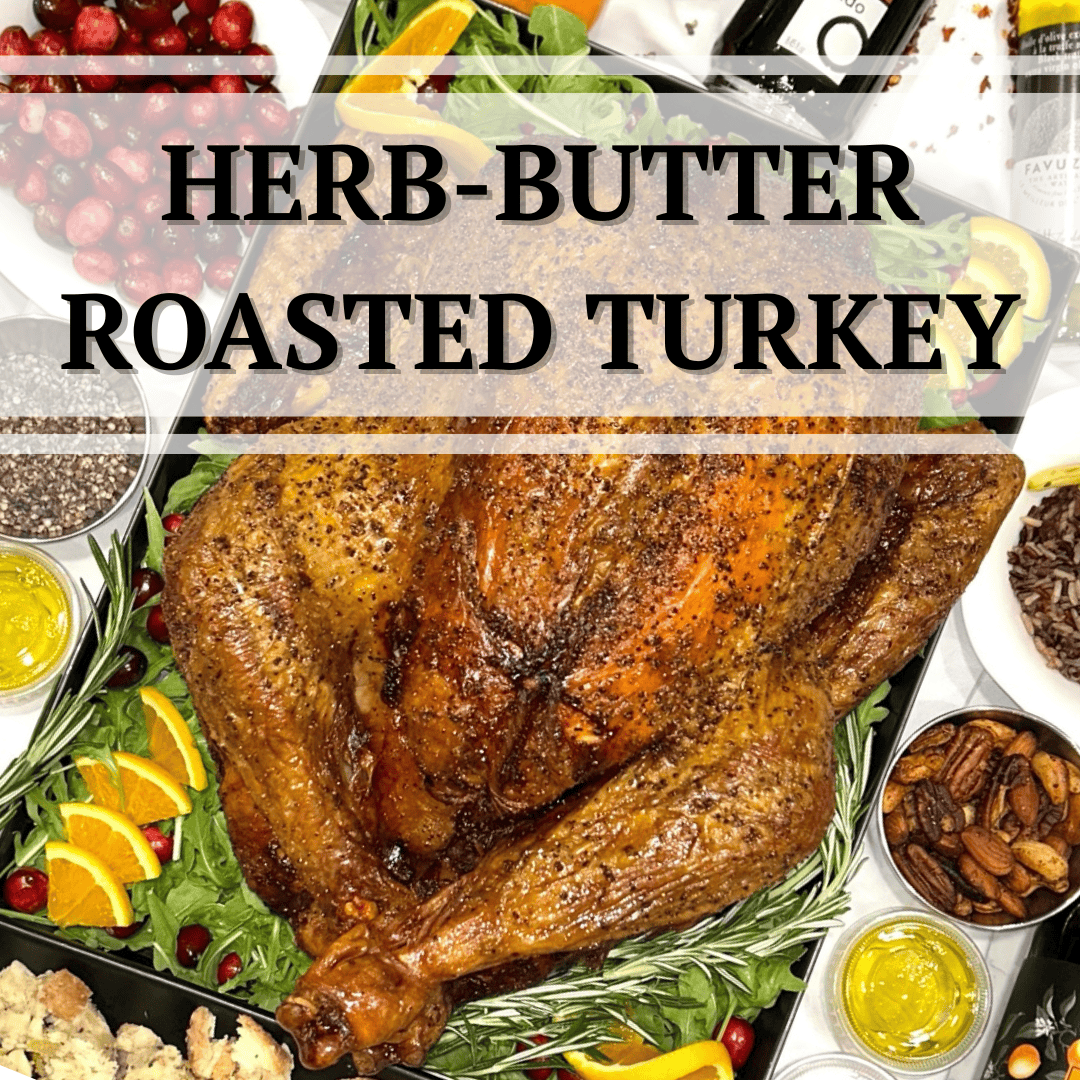Nothing says Thanksgiving like a golden, crisp-skinned roast turkey glistening in herb butter. It’s the centerpiece of the table, the one dish everyone looks forward to all year.
This version is everything you want. It’s juicy meat, crispy skin, and partnered with a rich, homemade gravy made from drippings and giblet broth.
Cooking a whole turkey can feel intimidating, but it’s simpler than it looks. Once you understand the timing, prep, and temperature, it’s just about patience and butter—lots of butter.
What Is a Compound Butter?

A compound butter is simply softened butter mixed with herbs, garlic, salt, and sometimes lemon zest or spices. In this recipe, the herb butter is the flavor backbone. It infuses the meat with richness and aroma as it melts under the skin.
You can customize it too. Thyme, rosemary, parsley, and sage are all classics for Thanksgiving. Add a touch of lemon zest if you want brightness.
Tips for Cooking and Prepping
Over the years, I’ve learned that the key to a stress-free turkey day is starting early.
1. Thawing the Turkey

Thaw your turkey 1–2 days before Thanksgiving dinner. Overnight thawing won’t cut it. It takes about 24 hours for every 4–5 pounds of turkey in the refrigerator. Don’t rush this step, or your bird will cook unevenly.
2. Prepping the Bird
When it’s thawed, remove the little bag from the cavity, that’s the neck and giblets. Don’t throw them out. I boil them with onions, celery, and carrots to make a rich broth for the gravy. The liver’s your cook’s treat.
Pat the skin completely dry with paper towels. Moisture is the enemy of crisp skin. Then rub the turkey all over with olive oil or melted butter and sprinkle generously with salt and pepper, even inside the cavity.
3. Butter Under the Skin
This step makes all the difference. Carefully lift the skin around the breast area and spread your compound butter directly under it. It keeps the white meat moist and soaks the turkey with flavor as it roasts.
4. Roasting and Timing
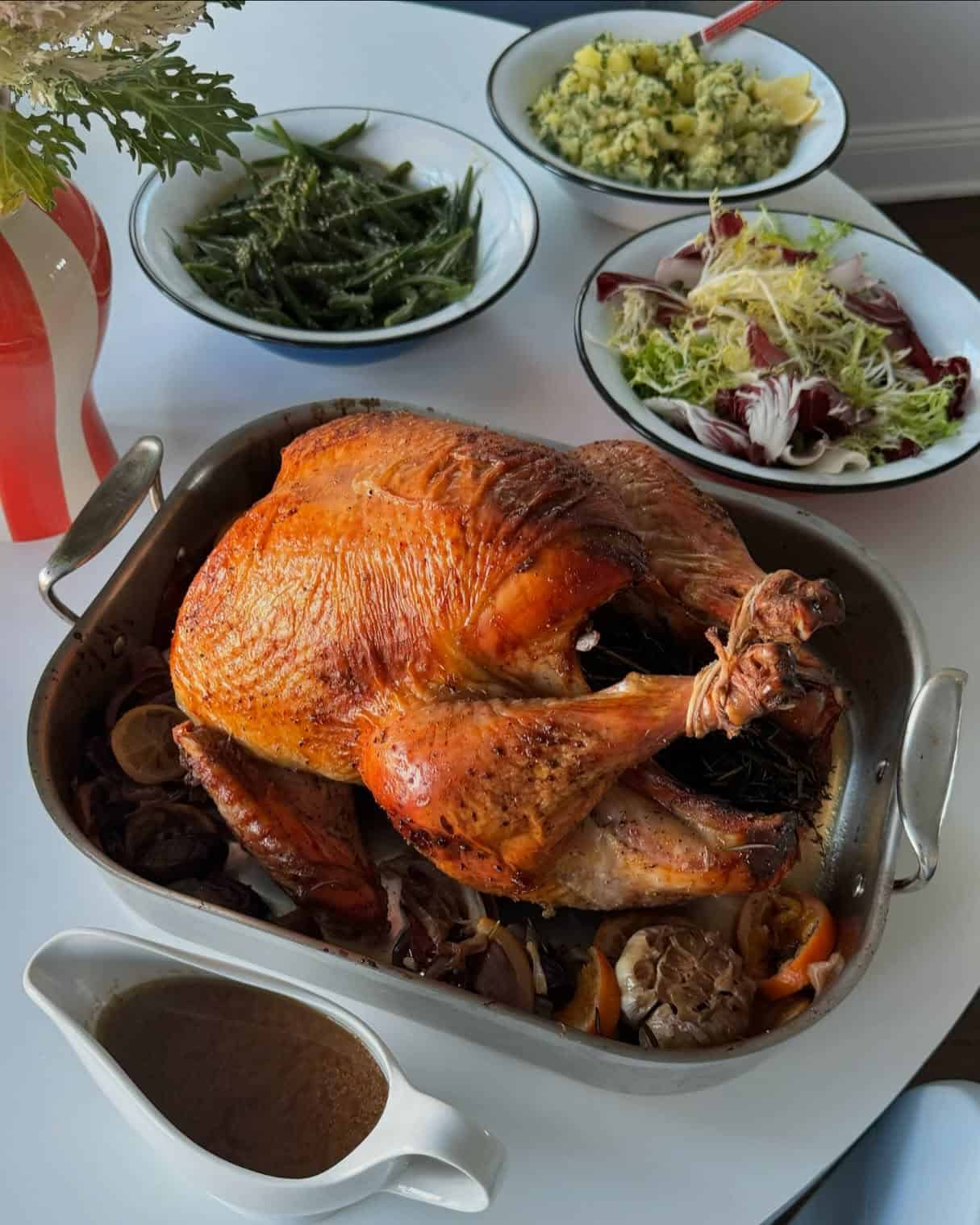
Count backward from when you plan to eat. Add at least 40 minutes before and after roasting for prep and resting. Preheat the oven in the morning, get the bird ready, and let it roast slowly until the skin turns deep golden brown.
If parts of the bird are still raw after cooking, don’t panic. Simply disassemble it and put the undercooked pieces back in the oven.
5. Resting and Carving
After roasting, rest the turkey for 30 minutes covered in foil. This allows the juices to settle, keeping the meat tender. Carve with a sharp knife, starting at the legs and working toward the breast.
What to Put Inside the Turkey Cavity
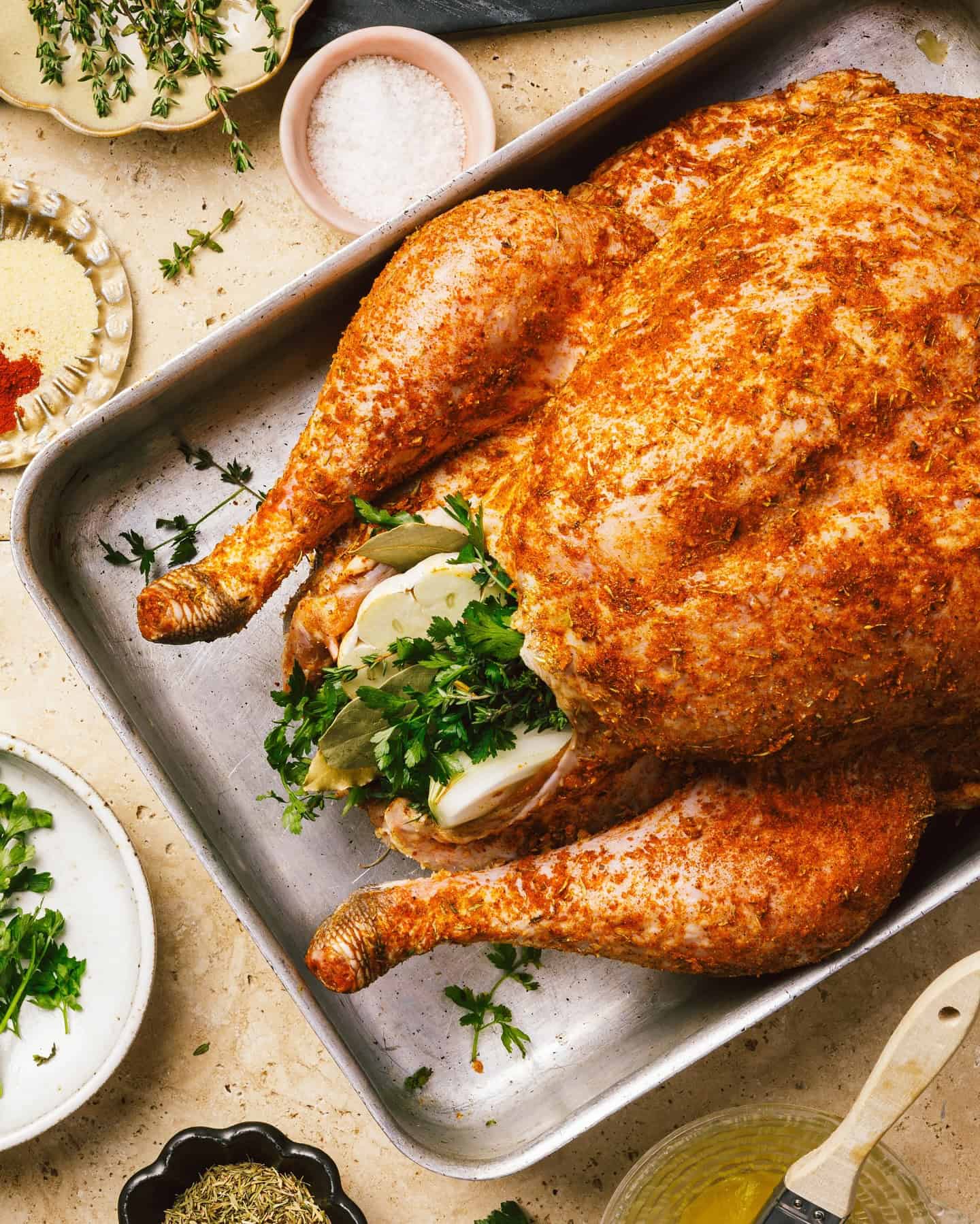
Stuff the cavity lightly with aromatics, not stuffing. I use a halved lemon, a head of garlic, onion quarters, and a few sprigs of rosemary or thyme. They infuse subtle fragrance into the meat without making the inside soggy.
If you prefer stuffing, bake it separately. That ensures both the turkey and stuffing cook safely and evenly.
How to Know When It’s Done
A meat thermometer is the most reliable tool here. Insert it into the thickest part of the thigh without touching the bone. The turkey’s done when it hits 165°F (74°C).
If you don’t have a thermometer, check that the juices run clear when you pierce the thickest part of the meat.
What If I Don’t Have an Oven?
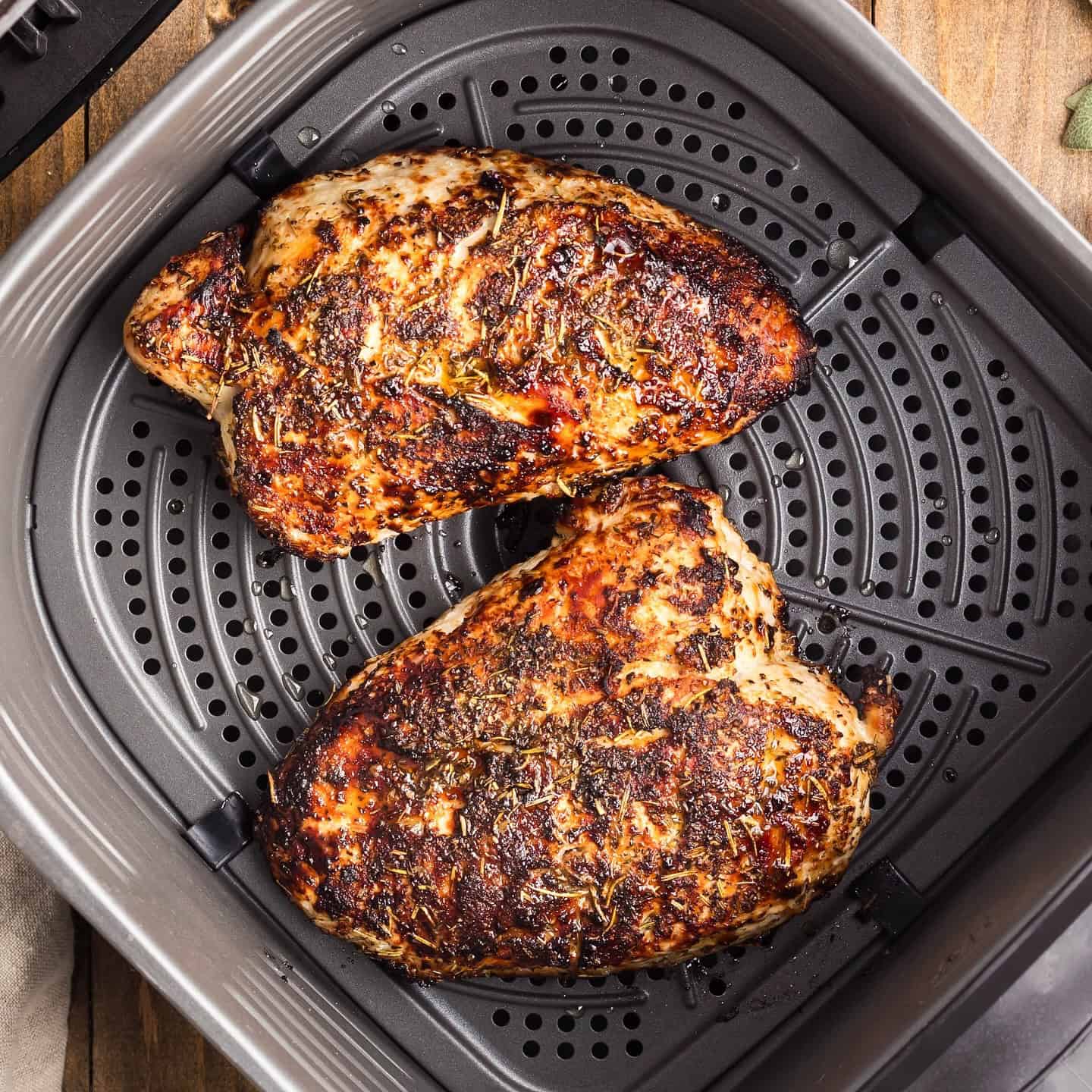
If you have an air fryer, you can roast turkey parts (like thighs or breast) instead of a whole bird. Brush them with herb butter and air-fry at 350°F (175°C) until golden and cooked through.
For stovetop cooking, use a large pot and simmer turkey pieces with herbs, onions, and broth. It won’t be roasted, but it’ll still be flavorful and moist.
What to Do With Leftovers
Leftover turkey is a gift. You can make turkey sandwiches, soup, fried rice, or even pasta. Save the bones and carcass for homemade stock. Use it as the base for the best soups and sauces.
If you have leftover gravy, freeze it in small containers. It reheats beautifully and makes any weekday meal feel cozy.
Storage and Make-Ahead Tips
Cooked turkey keeps well in the fridge for up to 4 days, tightly covered. You can also freeze it for up to 3 months.
You can make the herb butter and giblet broth a day or two ahead to save time on Thanksgiving morning.
Frequently Asked Questions
How long does it take to cook a turkey?
It depends on the weight. A good rule of thumb is 15 minutes per pound at 325°F (165°C) for an unstuffed turkey. Always check with a thermometer.
Can I brine my turkey?
Yes, and it’s worth it. Brining (soaking in saltwater or rubbing with salt overnight) seasons the meat deeply and keeps it juicy.
Do I cover the turkey while roasting?
Start uncovered for the first hour to let the skin crisp, then tent loosely with foil if it browns too quickly.
Can I make gravy without drippings?
You can! Just use butter, flour, and broth (store-bought or your giblet broth). The key is whisking slowly to avoid lumps.
What’s the best way to carve a turkey?
Let it rest first, then remove the legs and thighs, slice the breast against the grain, and arrange neatly on a platter.
Herb Butter Roast Turkey with Homemade Gravy Recipe
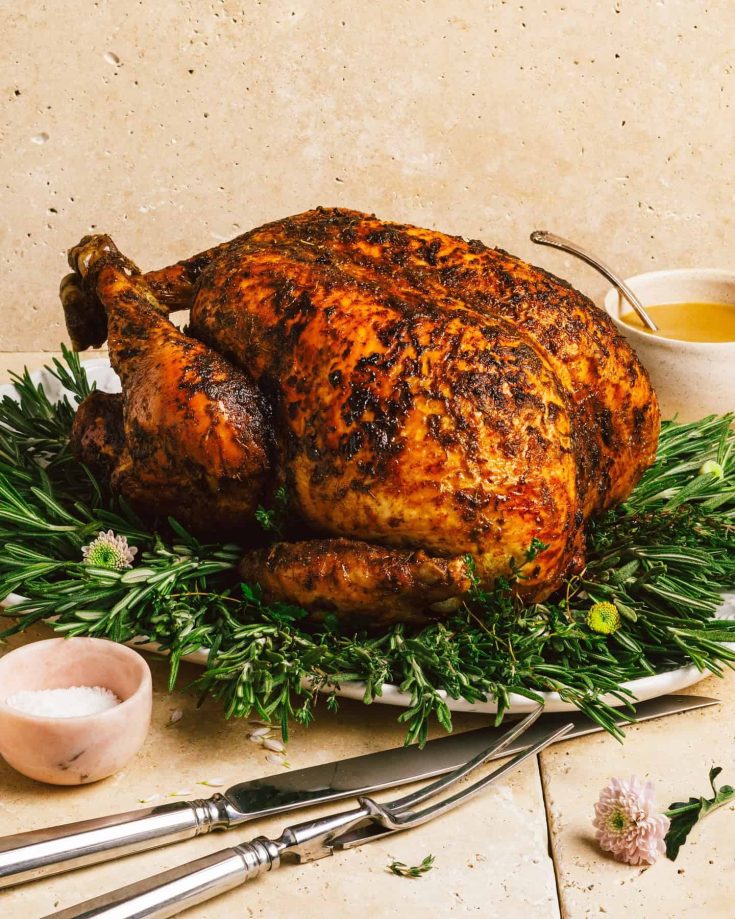
Image credit: @fooddolls
Ingredients
For the Turkey
- 1 whole turkey (12–14 lbs), thawed
- Salt and pepper, to taste
- 3 tablespoons olive oil or melted butter
- 1 lemon, halved
- 1 onion, quartered
- 1 garlic head, halved
- Fresh rosemary and thyme sprigs
For the Herb Butter (Compound Butter)
- 1 cup unsalted butter, softened
- 2 tablespoons chopped fresh thyme
- 2 tablespoons chopped rosemary
- 2 tablespoons chopped parsley
- 1 tablespoon minced garlic
- Zest of 1 lemon
- Salt and pepper, to taste
For the Giblet Broth and Gravy
- Turkey neck and giblets (from cavity)
- 1 onion, chopped
- 1 carrot, chopped
- 1 celery stalk, chopped
- 2 tablespoons butter
- 2 tablespoons flour
- 2–3 cups giblet broth or pan drippings
Instructions
- Thaw the turkey. Thaw in the refrigerator for 1–2 days. Never rush this step.
- Prepare the giblet broth. Remove the bag from the cavity, boil the neck and giblets with onion, celery, and carrot for about 45 minutes. Save the broth.
- Preheat the oven. Set to 325°F (165°C). Pat the turkey completely dry.
- Season and stuff. Rub olive oil or melted butter all over the turkey. Sprinkle generously with salt and pepper inside and out. Stuff the cavity with lemon, garlic, onion, and herbs.
- Add the herb butter. Gently loosen the breast skin and spread the compound butter underneath and over the surface.
- Roast. Place the turkey breast-side up on a rack in a roasting pan. Roast for about 15 minutes per pound, basting occasionally. Tent with foil if it browns too quickly.
- Check for doneness. Use a meat thermometer; the thickest part of the thigh should read 165°F (74°C).
- Rest and carve. Let the turkey rest, covered loosely with foil, for 30 minutes before carving.
- Make the gravy. In a saucepan, melt butter and whisk in flour until golden. Gradually whisk in drippings and giblet broth until thick and smooth. Season to taste.
Featured image credit: @bloorwestvillagebia

